Alternating Current Discharge Characteristics and Simulation Analysis of Rod-Plane Short Air Gaps under Salt Fog Conditions
Abstract
:1. Introduction
2. Experimental Work
2.1. Test Power Supply and Test Method
2.2. Artificial Climate Chamber and Air Gap Model
3. Experimental Results and Analysis
4. Simulation and Theoretical Analysis
4.1. Model Establishment
4.2. Simulation Results and Theoretical Analysis
5. Conclusions
- (1)
- Under AC voltage, corresponding to different gap distances the discharge voltage of the clean fog (18 μS/cm) condition is 15.1% to 35.5% higher than that of dry conditions, and the influence trend decreases with the increase of the gap distance.
- (2)
- With the increase of the conductivity of salt fog, the AC discharge voltage is 4.1% to 9.2% lower than that of clean fog conditions, and the influence trend of the conductivity on the AC discharge voltage is saturated with the increase of the conductivity.
- (3)
- As the simulation shows, the space electric field is seriously distorted by the salt fog. Due to the adsorption of free electrons by droplets in salt fog, the maximum value of electric field intensity on the axis between rod and plane under clean fog condition is 15.87% to 19.81% lower than that under dry conditions.
- (4)
- The simulation results show that the electric field intensity in air gap increases with the increase of the conductivity corresponding to different gap distances. As the conductivity of salt fog increases from 18 to 4000 μS/cm, the maximum value of the electric field intensity on the axis increased from 4.90% to 8.62%.
Author Contributions
Acknowledgments
Conflicts of Interest
References
- Niu, H.; Zhuang, X.; Yi, Z.; Liu, Y.; Zhang, G. Meteorological Condition of Dramatic Decline of Air Gap Breakdown Voltage. High Volt. Eng. 2014, 40, 3343–3348. [Google Scholar]
- Kang, J.; Li, P.; Wang, S.; Tan, F.; Qu, Q.; He, Z. Influence of Salt Spray on AC/DC Breakdown Voltage of Rod-plane Gap. High Volt. Eng. 2015, 41, 1989–1994. [Google Scholar]
- Su, Z. Influences of Fog-Haze on External Insulation of Transmission and Distribution Equipments. Power Syst. Technol. 2013, 8, 2284–2290. [Google Scholar]
- Fuang, S.; Li, M.; Zhang, X.; Zhang, G. Overvoltage Calculation and Selection of Switching Impulse Minimum Air Gap for 500 kV Double-Circuit Transmission Line on Same Tower. Insul. Surge Arrest. 2016, 2, 106–110. [Google Scholar]
- Vasudev, N.; Ravi, K.N.; Mujumdar, A.K. Breakdown characteristics of rod-plane gap under salt fog for AC and DC voltages. In Proceedings of the Annual Conference on Electrical Insulation and Dielectric Phenomena, Pocono Manor, PA, USA, 28–31 October 1990; pp. 581–586. [Google Scholar]
- Electrical Insulation and Dielectric Phenomena. Available online: https://ieeedeis.org/event/conference-on-electrical-insulation-and-dielectric-phenomena/ (accessed on 17 August 2018).
- Mei, Z. The Effeets of various atmospheriec conditions on the breakdown vollages of Rod-Plane air gap. High Volt. Eng. 1990, 1, 39–44. [Google Scholar]
- Deng, H.; Hackam, R.; Chang, R.J. Effects of fog salinity, air pressure and water flow rate on ac flashover of iron-rod short air gaps. In Proceedings of the Electrical Insulation and Dielectric Phenomena, Virginia Beach, VA, USA, 22–25 October 1995; pp. 145–148. [Google Scholar]
- High-Voltage Test Techniques—Part 1: General Definitions and Test Requirements. Available online: https://global.ihs.com/doc_detail.cfm?&csf=TIA&document_name=IEC%2060060-1&item_s_key=00035813&item_key_date=890331 (accessed on 17 August 2018).
- Li, Z. Fog research in China in recent 40 years. ACTA Meteorol. Sin. 2001, 5, 616–624. [Google Scholar]
- Masayuki, S. High-efficiency Sterilizer by High-voltage Pulse using Concentrated-Field Electrode System. IEEE Trans. Ind. Apply 2001, 37, 1646–1650. [Google Scholar]
- Ye, Q. Study on Mixed Two-Phase Discharge and Its Application in Water Treatment. Ph.D. Thesis, Huazhong University of Science and Technology, Wuhan, China, January 2001. [Google Scholar]
- Yang, C. Theoretical and Experimental Study on the Phenomena/Mechanism of Discharge in Air-Water Two-Phase Mixture. Ph.D. Thesis, Huazhong University of Science and Technology, Wuhan China, October 2005. [Google Scholar]
- Hu, J. Research on Discharge Characteristics and Mechanism of Rod-Plane Short Air Gaps in Natural Fog. Ph.D. Thesis, Chongqing University, Chongqing, China, May 2013. [Google Scholar]
- Sunka, P.; Babicky, V.; Clupek, M.; Lukes, P.; Simek, M.; Schmidt, J.; Cernák, M. Generation of Chemically Active Species by Electrical Discharges in Water. Plasma Sources Technol. 1999, 8, 258–265. [Google Scholar] [CrossRef]
- Dong, B. Study on Effect of Fog on Discharge Performance of Short Air Gaps and Insulators. Ph.D. Thesis, Chongqing University, Chongqing, China, May 2014. [Google Scholar]
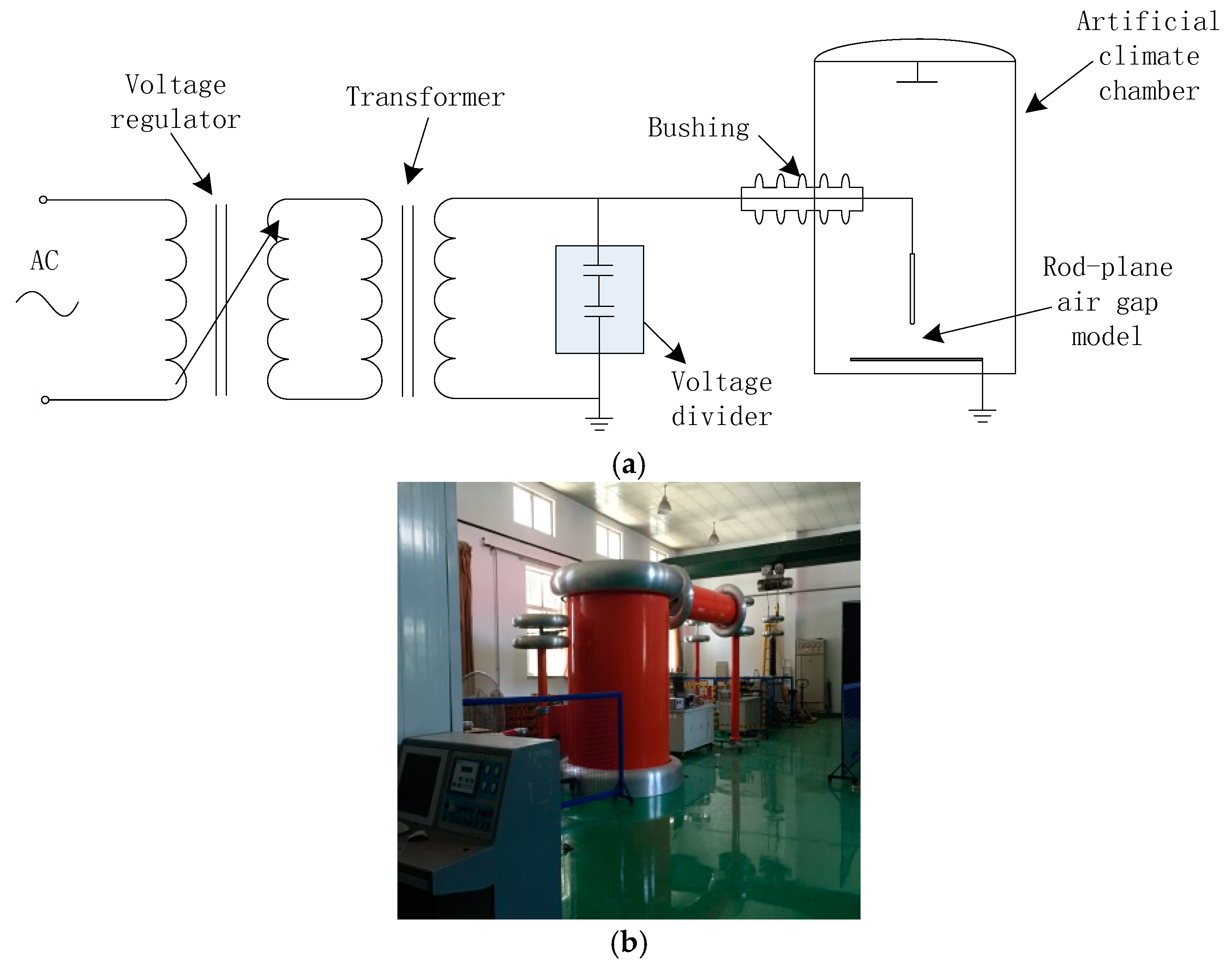
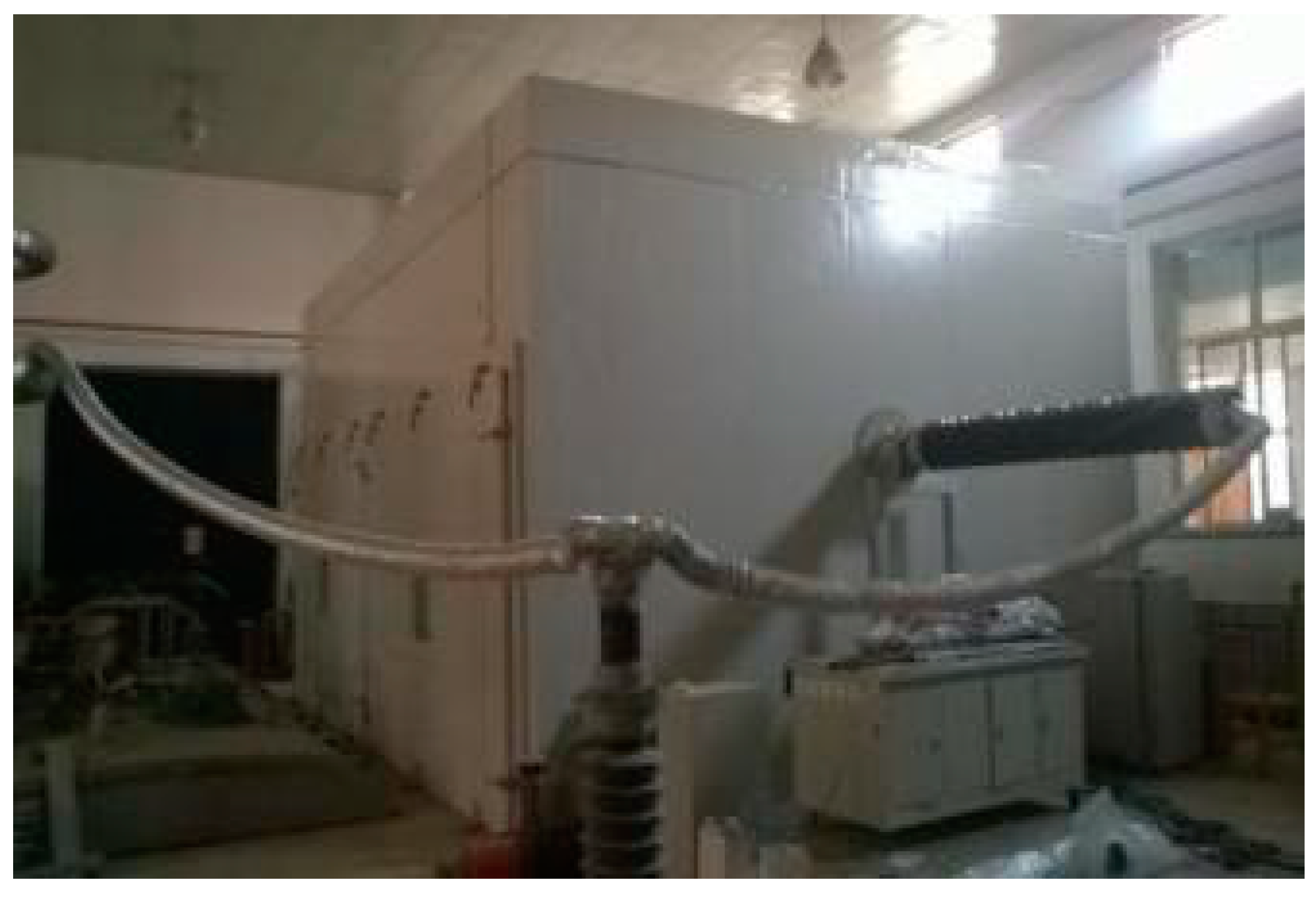



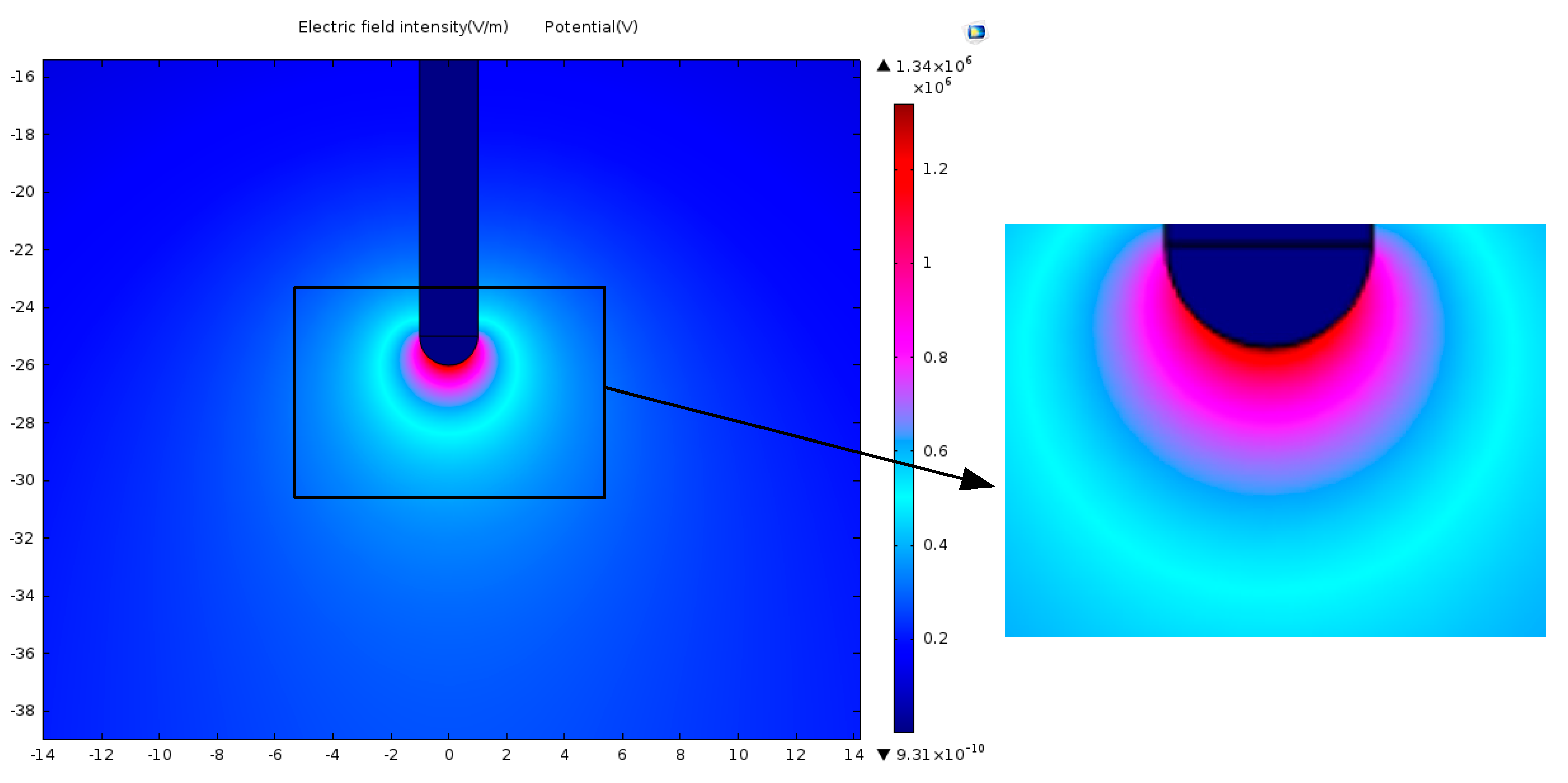
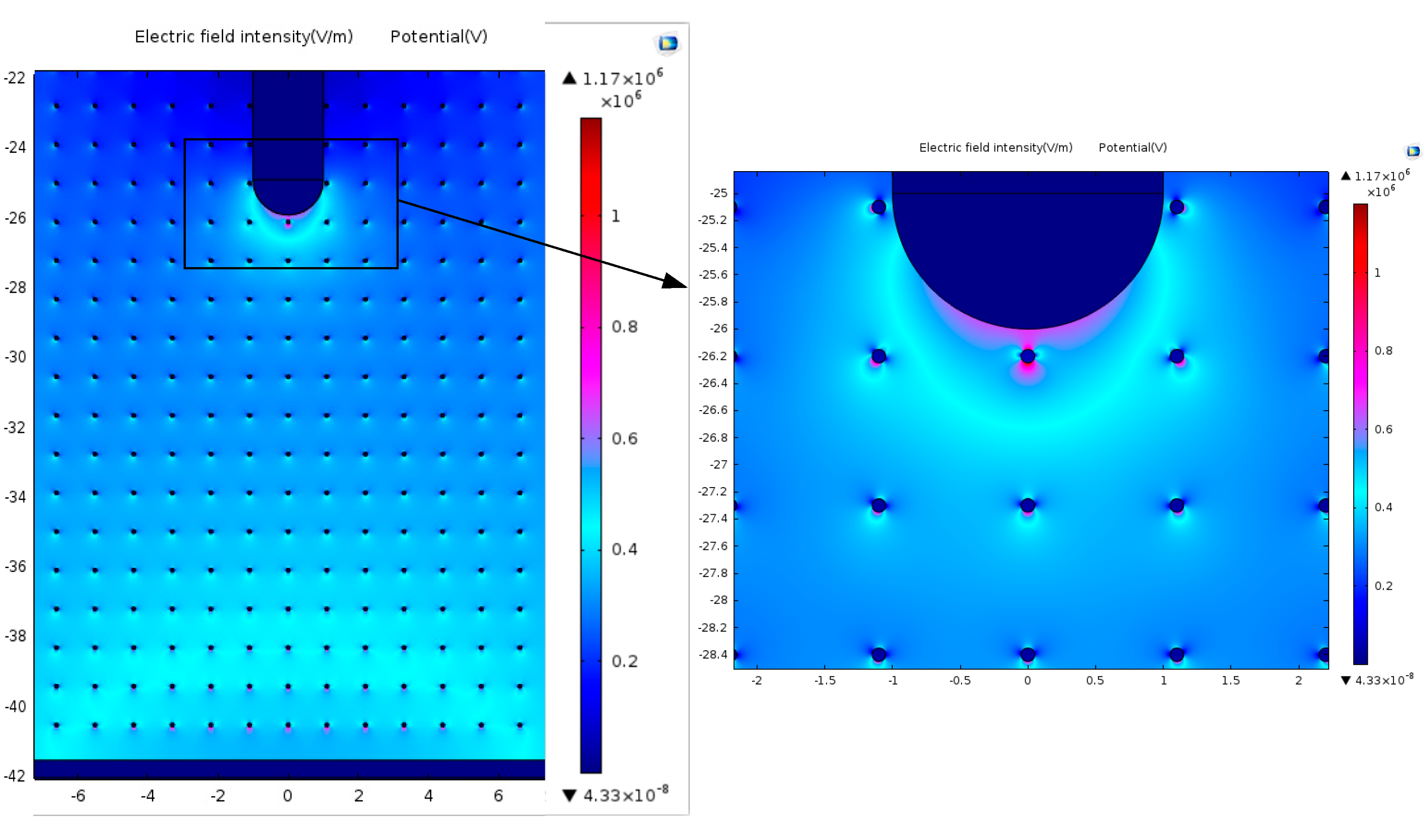


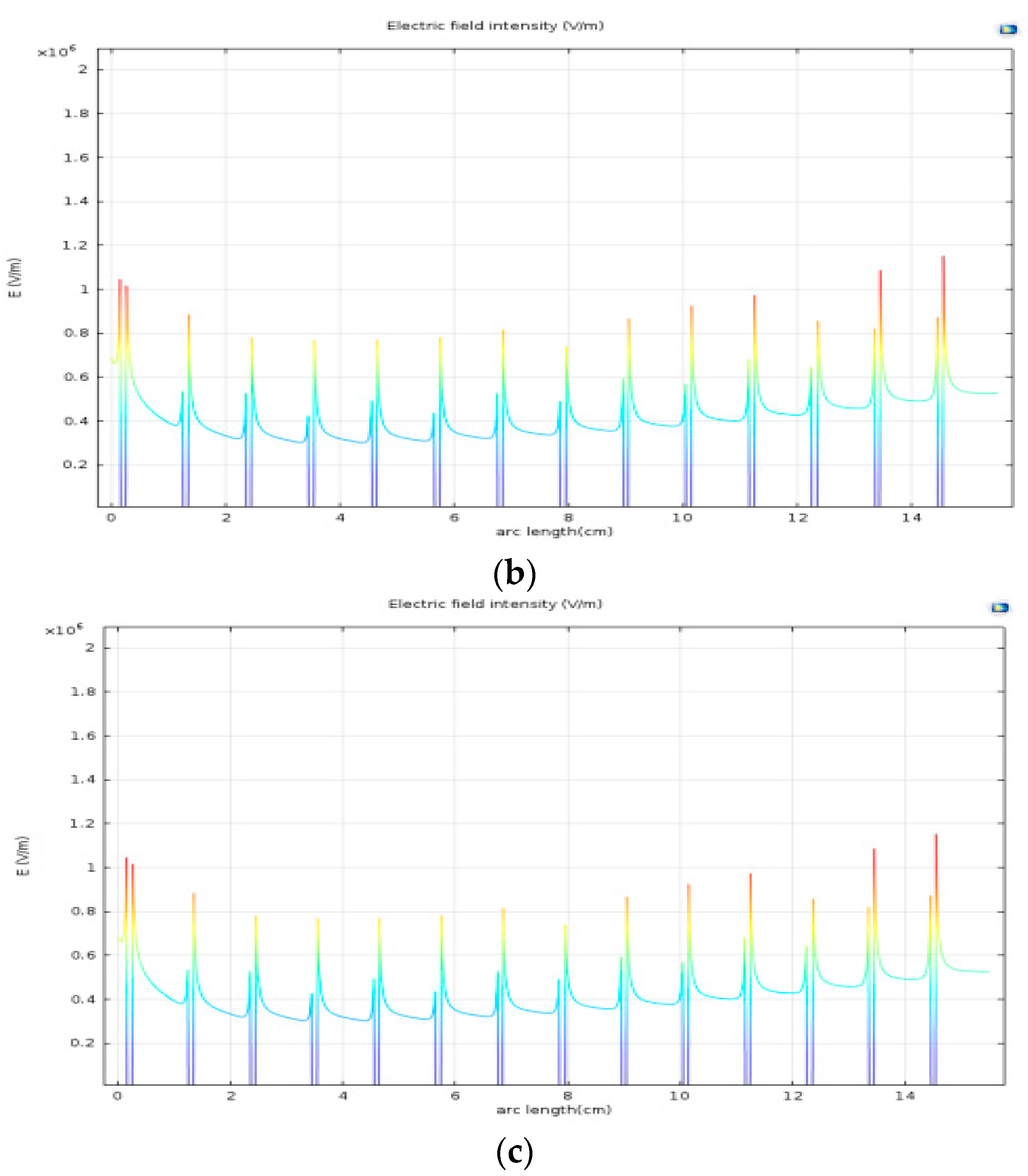

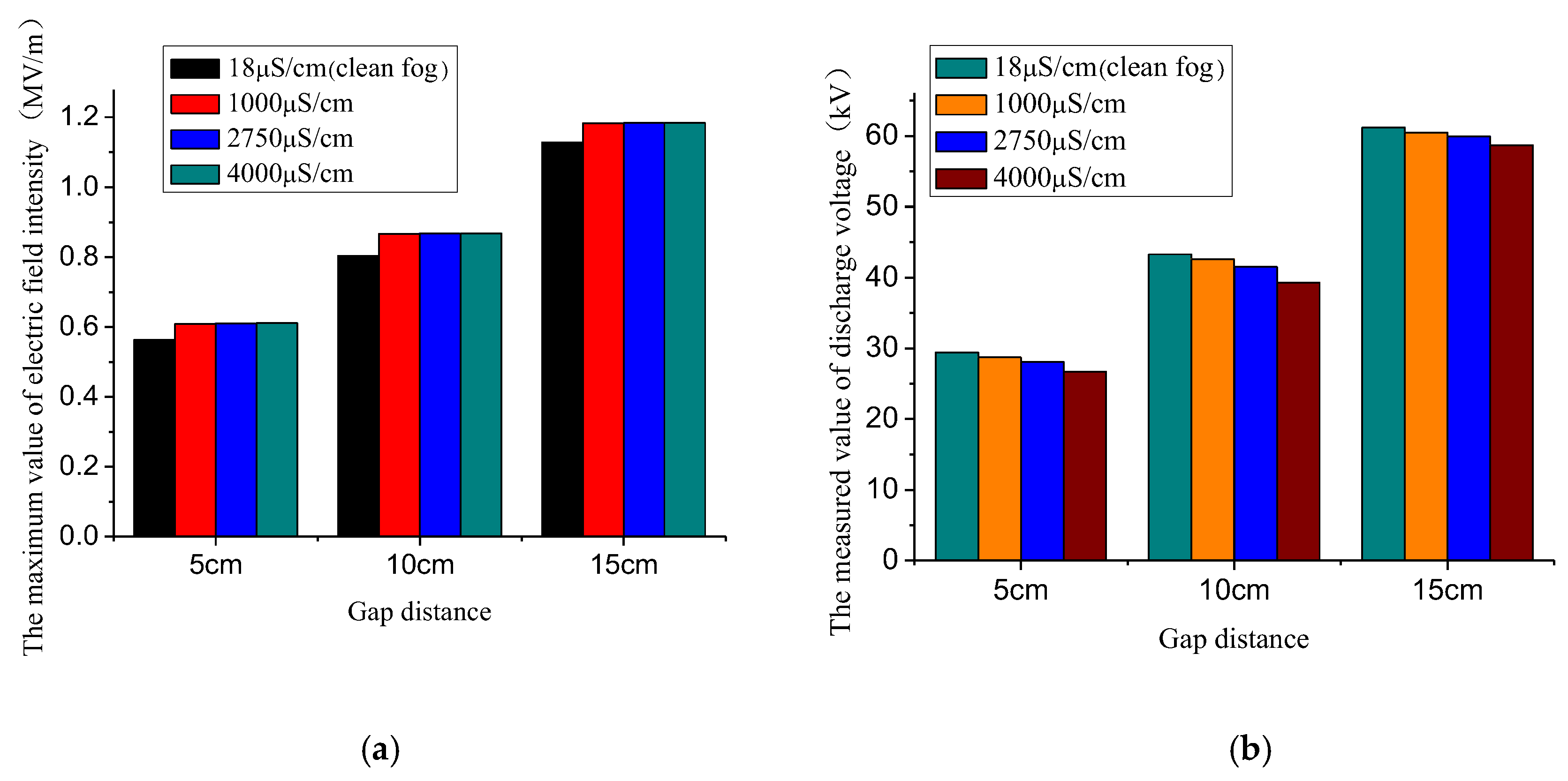
| Voltage Type | Gap Distance | Discharge Voltage (kV) | ||||
|---|---|---|---|---|---|---|
| Dry | The Conductivity of Fog | |||||
| 18 μS/cm (Clean Fog) | 1000 (μS/cm) | 2750 (μS/cm) | 4000 (μS/cm) | |||
| AC voltage | 5 cm | 21.7 | 29.4 | 28.7 | 28.1 | 26.7 |
| 10 cm | 35.9 | 43.3 | 42.6 | 41.5 | 39.3 | |
| 15 cm | 53.2 | 61.2 | 60.5 | 59.9 | 58.7 | |
| Gap Distance | Dry | 18 mS/cm (Clean Fog) | 1000 μS/cm | 2750 μS/cm | 4000 μS/cm |
|---|---|---|---|---|---|
| 5 cm | (21.1, 22.3) | (28.4, 30.4) | (28.1, 29.3) | (27.3, 28.9) | (25.9, 27.5) |
| 10 cm | (34.8, 37.0) | (42.1, 44.5) | (41.4, 43.8) | (40.2, 42.8) | (38.0, 40.6) |
| 15 cm | (51.8, 54.6) | (60.2, 62.2) | (58.6, 62.4) | (58.4, 61.4) | (57.0, 60.4) |
| Material | Aluminum (Rod Electrode) | Iron (Plane Electrode) | Air (Air Domain) | Water (Fog Drop) |
|---|---|---|---|---|
| Relative permittivity | 1 | 1 | 1 | 81 |
| Conductivity (μS/cm) | 3.774 × 103 | 1.12 × 103 | 10−10 | 1.8 × 10−7 |
| Gap Distance | The Maximum Value of Electric Field Intensity | ||
|---|---|---|---|
| Dry (ED) | Clean Fog (EC) | ||
| 5 cm | 0.6271 MV/m | 0.5029 MV/m | 19.81% |
| 10 cm | 0.9124 MV/m | 0.7433 M/m | 18.53% |
| 15 cm | 1.3414 MV/m | 1.1285 MV/m | 15.87% |
| Gap Distance | The Maximum Value of Electric Field Intensity | |||
|---|---|---|---|---|
| Clean Fog (18 μS/cm) | 1000 μS/cm | 2750 μS/cm | 4000 μS/cm | |
| 5 cm | 0.5629 MV/m | 0.6089 MV/m | 0.6106 MV/m | 0.6114 MV/m |
| 10 cm | 0.8033 MV/m | 0.8667 MV/m | 0.8678 MV/m | 0.8682 MV/m |
| 15 cm | 1.1285 MV/m | 1.1830 MV/m | 1.1837 MV/m | 1.1838 MV/m |
© 2018 by the authors. Licensee MDPI, Basel, Switzerland. This article is an open access article distributed under the terms and conditions of the Creative Commons Attribution (CC BY) license (http://creativecommons.org/licenses/by/4.0/).
Share and Cite
Liu, Y.; Jiang, S.; Zhong, Z.; Geng, J.; Lv, F. Alternating Current Discharge Characteristics and Simulation Analysis of Rod-Plane Short Air Gaps under Salt Fog Conditions. Energies 2018, 11, 2251. https://doi.org/10.3390/en11092251
Liu Y, Jiang S, Zhong Z, Geng J, Lv F. Alternating Current Discharge Characteristics and Simulation Analysis of Rod-Plane Short Air Gaps under Salt Fog Conditions. Energies. 2018; 11(9):2251. https://doi.org/10.3390/en11092251
Chicago/Turabian StyleLiu, Yunpeng, Shuo Jiang, Zheng Zhong, Jianghai Geng, and Fangcheng Lv. 2018. "Alternating Current Discharge Characteristics and Simulation Analysis of Rod-Plane Short Air Gaps under Salt Fog Conditions" Energies 11, no. 9: 2251. https://doi.org/10.3390/en11092251
APA StyleLiu, Y., Jiang, S., Zhong, Z., Geng, J., & Lv, F. (2018). Alternating Current Discharge Characteristics and Simulation Analysis of Rod-Plane Short Air Gaps under Salt Fog Conditions. Energies, 11(9), 2251. https://doi.org/10.3390/en11092251






